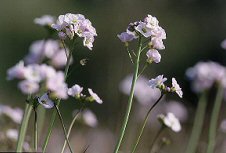Countryside Rangers Diary
April
Spring is here! The vegetation is changing from the browns and greys of the winter to lush greens.
Hawthorn is the first common tree to come into full leaf. However, it is beaten to flowering by the Blackthorn (sloe) which blooms usually at the end of March, beginning of April.
 Keep an eye out for Lady’s smock (cuckoo flower). You can see it’s pink flowers in the damp grassy areas of the marsh, especially over in the deer park. It is the larval plant of the orange tip butterfly. The two warm weeks at the end of March started the emergence of many butterflies from winter hibernation. Several peacocks and red admirals were seen.
Keep an eye out for Lady’s smock (cuckoo flower). You can see it’s pink flowers in the damp grassy areas of the marsh, especially over in the deer park. It is the larval plant of the orange tip butterfly. The two warm weeks at the end of March started the emergence of many butterflies from winter hibernation. Several peacocks and red admirals were seen.
We are waiting for the arrival of our spring migrant birds. They have spent the winter in warmer parts of the world. Chiffchaffs and willow warblers are the first to arrive, these two birds look very similar but have quite different songs.
The first swallow, we hope, will arrive during the first week in April, last year one was seen on April 8th. If you do spot one please let one of the Rangers know.
It’s a busy time for nesting birds. Blackbirds and song thrushes lay their first clutch of eggs in low scrub.
The Pere David deer are giving birth to their calves at the moment. We hope to have up to 10 new additions this year! April is the month that the fallow and red deer males shed their antlers. Each year they grow a bigger and more impressive set. The antlers don’t always fall off at the same time, one may fall followed by the next several days later. This is why you may see deer with just one antler!
Fox and badger cubs are ready to emerge from their homes at dusk. They spend time exploring and playing with their littermates.
Sweet vernal grass Anthoxanthum odoratum has a wonderful smell of new-mown grass when crushed. It makes intensely fragrant hay, is one of the first grasses to flower in spring. If you look closely, you'll notice that the flower spike changes sex during development. White, feathery stigmas (female) emerge first, followed by purple, dangling stamens (male) after the stigmas wither. This mechanism, called protogyny, encourages cross-pollination between plants, rather than self-pollination. ST MARK'S-FLIES, Bibio marci, gather in large groups, they appear to dance dangling their legs in sunny sheltered gaps in the hawthorn hedges. The males perform their up-and-down flights around St Mark's Day, 25th April. The young stages live in the soil or amongst rotting vegetation. Keep a watch for these distinctive flies.
Down in the gardens….
April is the time for the daffodils and tulips in the Orangery Terrace flower beds. What a spectacular sight.
Bring your cameras along and get a snap!!